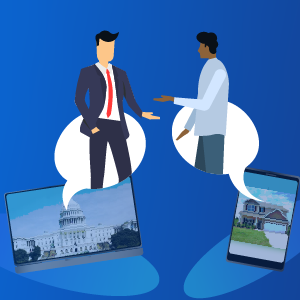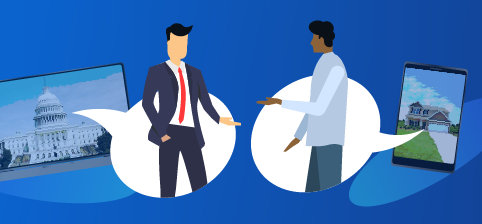What are the best ways for governments to quickly help lots of people get information and assistance? Some might say web sites, self-service or mobile. The answer is whatever tool or channel is most convenient at the time. The challenge is how to deliver that flexibility.
With large numbers of citizens looking for help, delivering a modern digital experience has become mission critical for agencies. Digital experience platforms enable the content integration, personalization, and management necessary to meet these needs, now and in the future.
 Higher Citizen Expectations Is the New Normal
Higher Citizen Expectations Is the New Normal
While 81% of government agencies strive to become digital organizations, there are critical challenges to overcome. Citizens have become accustomed to streamlined, engaging, and responsive digital engagement from consumer sites. They expect the same level of ease when filling out applications, accessing government payment details, or just asking a question. However, the vast majority of agencies fall short of meeting citizen expectations.
Results from Forrester’s Federal Customer Experience Index show that 80% of federal agencies rank in the lowest two categories of customer experience. In contrast, only 20% of consumer brands landed in the bottom two categories. And less than half of citizens are willing to say positive things about the digital interactions they’re having with government agencies.
The starting point for agencies to deliver a truly modern digital experience that meets citizen expectations is having the right solution – one that responds to citizen demands, enables agencies to achieve internal goals, and provides the experience citizens want.
The Advantage of Digital Experience
With a digital experience platform (DXP), agencies gain a solution that has the potential to aggregate disparate systems, content, and applications. Deployed effectively, these solutions provide a personalized, relevant, and cohesive citizen journey. And the best ones can be customized to meet both agencies’ unique requirements and the needs of citizens.
- Connecting Disparate Systems
Legacy systems that lack integration capabilities and scalability are common challenges for agencies. Hindering the goal of optimizing digital experiences, outdated technology also results in fragmented and incomplete data. Yet, according to the U.S. Government Accountability Office, more than 80% of government IT spending is on operating and maintaining legacy systems. Successful digital transformation hinges on the ability to bridge legacy and modern systems – combining data on a single, modern digital platform.
In the case of the U.S. Navy, a lack of connected systems and databases prevented the expansion of a portal for sailors to manage their careers throughout their military service. Through the deployment of a DXP, the Navy was able to move everything to a single solution that met their performance requirements and delivered an improved user experience. Their DXP solution also allows future expansion of the portal so that it can continue to be a vital career planning tool for sailors.
- Increasing Personalization
Citizens naturally want streamlined digital experiences that address their specific needs, and a growing number of citizens are choosing self-service over direct human contact. With the right DXP, agencies can apply persona modeling, journey mapping, responsive layout, and data-driven design to increase personalization and relevancy. By learning and adapting to user behaviors and feedback, the personalization can increase over time, enabling experiences that are immediately personal, easy-to-use, and meaningful. And this type of contextual experience should be delivered across all live and self-service engagement channels, including mobile devices.
The personalization capabilities of a DXP have been uniquely leveraged by the Global Learning and Observations to Benefit the Environment (GLOBE) Program, sponsored by NASA. An example of how this program used their DXP can be found with the solar eclipse of 2017. The team at GLOBE chose the identity management features of the platform to keep track of approximately 50,000 users taking eclipse-specific measurements. In the end, meaningful data obtained from the global citizen scientists was crowdsourced to better understand the earth’s system and global environment.
- Improving Content Management
Insufficient and outdated data continues to limit government agencies’ ability to meet expectations – creating hassles for both citizens and government employees. Ineffective communication, difficulty finding information, and manual processing of paperwork all contribute to inefficiencies. A DXP can solve these common content challenges by managing the lifecycle of content from creation to publishing, storage, maintenance, and deletion.
Effective communication means getting the right content to the right people at the right time. Whether working from home or in the office, operating in normal or crisis mode, ready access to current content is only getting more important. How organizations communicate to citizens and staff, onsite or off-site, will be front and center as they continue to achieve their missions. The best DXP brings together disparate systems and modernizes intranets to deliver the integrated and personalized, anytime, anywhere, any device communications that people need.
Looking for guidance to improve your agency’s digital experience? Download the Liferay infographic Transform Government into a Modern Digital Experience.







